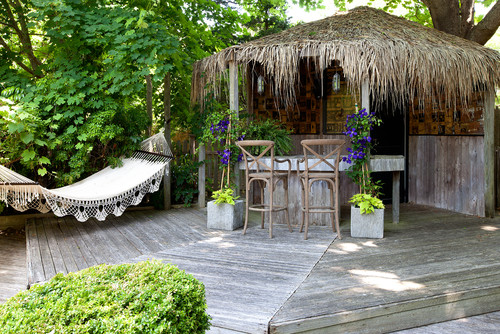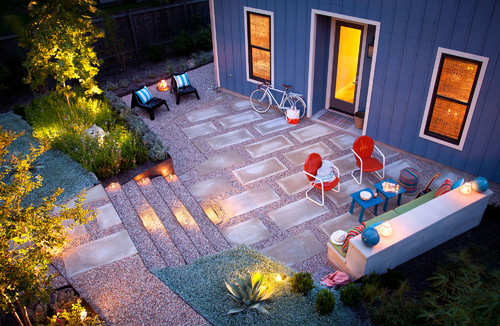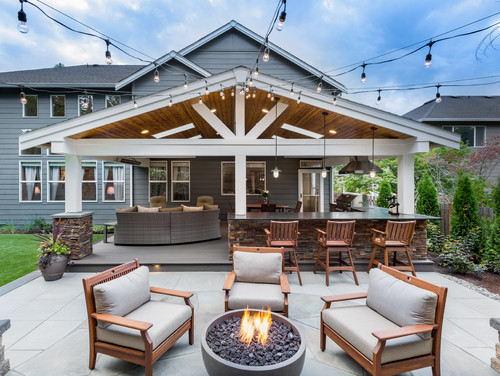How to Get Started on Landscape Redesign
How to Get Started on a Landscape Redesign
Whether you are starting from scratch or are reimagining the outdoor space of somewhere you’ve lived for years, getting started on a landscape redesign can feel like a daunting task. The prep work that you do upfront — maybe even before you start contacting professionals — can streamline conversations and save time down the line.
Nailing down your budget, how you’d like to use the space and what landscape styles appeal to you most can help keep a project on track and ensure that you’re happy with the end result. As a first step, read this guide and take a critical look around your yard.

[caption width="500" align="alignnone"]Photo by Andrew Grossman - Landscape Design[/caption]
Assess Your Existing Landscape
What do you want to change? What do you want to keep? Distinguish the areas you’d like to reimagine, the ones you’d like to stay the same and anything that falls in between — spots that don’t need to be entirely redone but that could benefit from small updates, such as changing the material of a path or replanting a bed beneath a mature tree.
What problem areas exist? If lack of privacy from neighbors is an issue, factoring in a combination of fencing and plants for screening may be one of your backyard priorities. Are there any site-specific challenges, such as an underutilized slope or a poorly draining corner? A professional will be able to tackle these situations and help set your budget accordingly.

[caption width="500" align="alignnone"]Photo by Cezign - Tropical Deck[/caption]
Establish a Garden Wish List
Now we’re getting to the fun part. If the sky were the limit, what would be in your dream garden? Would you have an outdoor lounge? Poolside cabana? Full-size pizza oven? Saltwater pool? Dreamy outdoor lighting? Try not to get bogged down in the cost or feasibility of each element, but use this as a brainstorming exercise that may help reveal the different or coinciding dreams of the people involved in the project.
Once you’ve written everything down on your wish list, review it and identify which elements are top priorities, which ones are less important and any that aren’t possible this time around. You can circle back to this list at any point in the project as you evaluate where to save and where it might be worth it to splurge.

[caption width="500" align="alignnone"]Photo by B. Jane Gardens - Modern Patio[/caption]
Consider How You’d Like to Use Your Outdoor Space
As part of coming up with your garden wish list, or as a separate exercise, identify the activities you’d like to do in your new outdoor space. Do you want to use it for dining? If so, for how many people? Maybe you would like to create a lounge or a space for growing edible plants.
Identifying your outdoor-use priorities and the number of people you’d like to accommodate can help determine the size of a future deck or patio, for example. It also will help the designer better understand what to place where in the landscape.
Go a step further and think about when you’d use each area of the yard. If you’re hoping to use a lounge during the evening, for example, you may want to plan for sources of light and heat. Like a fire pit.

[caption width="500" align="alignnone"]Photo by Kate Eyre Garden Design - Contemporary Landscape[/caption]
Also think about practicalities that you may have forgotten. Do you need storage for outdoor tools or sports equipment? Do you have a place to put garbage and green-waste bins?

[caption width="500" align="alignnone"]Photo by Urban Oasis Design & Construction, LLC - Transitional Patio[/caption]
Set a Budget and Consider Phased Construction
Establish how much you can afford to spend on a landscape redesign. If you have enough funds set aside for the entire project, you can complete the design and installation at once. It’s also possible to break up a project into smaller, more budget-friendly phases. This is called phased construction.
Tip: If you do decide to phase the construction, it’s best to first work with a backyard design professional on a complete master plan. He or she will be able to tell you what makes the most sense in terms of installation order and which projects can be bundled together.

[caption width="500" align="alignnone"]Photo by BOXHILL - Beach Style Patio[/caption]
Refine Your Landscape Design Style
Determining or refining your landscape design style is an important part of your project, so take your time with this step. Start by creating a Houzz ideabook to save images of landscapes that appeal to you.
Cast a wide net during your initial inspiration-gathering phase, but then edit your images to feature one or two defining styles. Aim for styles that fit with your climate and site and your home’s architecture. This will help set your project off on a clearer direction and result in a more cohesive landscape.
Your landscape designer also can help guide you through this process by explaining how a certain style can be achieved with plants that grow well in your area or by working within your proposed budget.

[caption width="500" align="alignnone"]Image Credit: www.Houzz.com[/caption]
Get an Existing Site Plan
Pull out copies of your home’s blueprints, if you have them, and look for an overall site plan that shows property boundaries, existing outdoor features like mature trees and the locations of utility lines. If you can’t find a copy of your home’s site plan, most city or county planning departments will have it on file and can give you a copy for a fee.
If the site plan is up to date, your landscape architect or designer will be able to use it as the foundation for your new landscape plan. If your plan is not up to date, you will need to carefully remeasure your property or hire a property surveyor to do so. Site measurement also can be handled by a contractor, landscape designer or landscape architect and can be bundled in the cost of your landscape redesign.
Make multiple copies of a current site plan once you have one. You’ll need them down the line to draw up designs and hand over to landscape professionals.

[caption width="500" align="alignnone"]Photo by C&H Landscaping[/caption]
Learn the Basics About What Grows in Your Area
It’s well worth it to familiarize yourself with plants that you may want to add to your yard, regardless of whether you’re working with a professional. If you want your plants to have specific characteristics — including drought tolerance and attractiveness to wildlife — consider working with a local professional who specializes in those plant types.
Plant knowledge, whether your own or a professional’s, can help save you time and money by getting the right plant in the right place from the start. The plants you choose also will affect the cost of the water and maintenance required to keep them thriving.

[caption width="500" align="alignnone"]Photo by Jeremy Allen Garden Design[/caption]
Tell us: Are you planning a landscape redesign? What helped you get started on your project? Share your thoughts in the Comments.
NOTE: How to Get Started on a Landscape Redesign was written by Lauren Dunec Hoang and was initially published on www.houzz.com.
From Dream Backyard Builders
Florida Coastal Contractors is local paver patio contractor and pergola builder in St Augustine, FL area. We are licensed and Insured contractor and are ready for any backyard improvement project you might be thinking about. Call our local office at (904) 827-3962 to schedule your free consultation and quote for your project. We look forward to helping you create a dream backyard your family and friends will enjoy for time to come.
Check reposted source here: How to Get Started on Landscape Redesign
Comments
Post a Comment